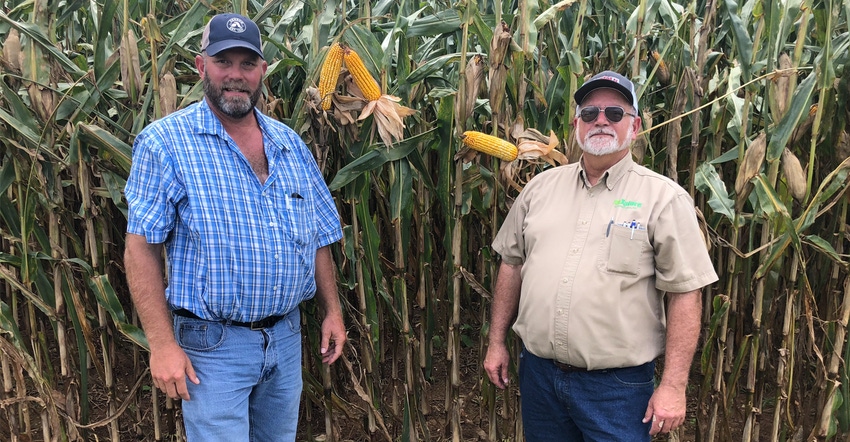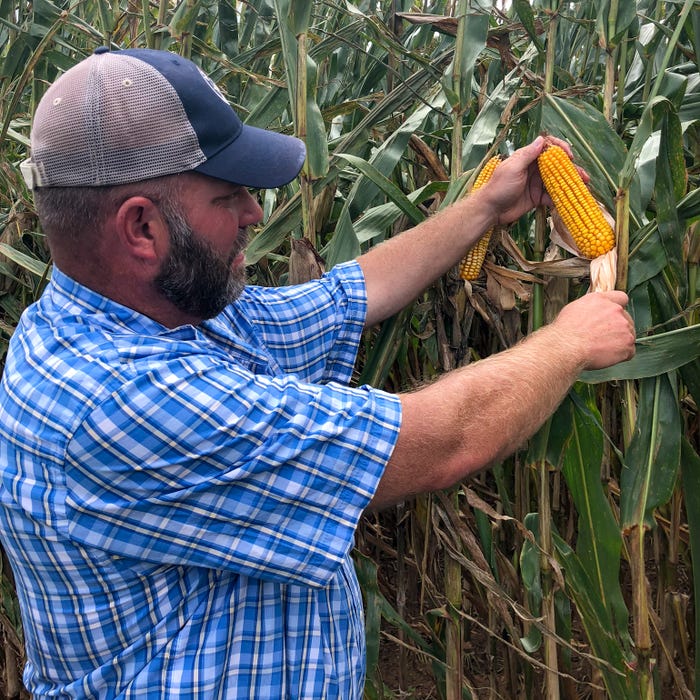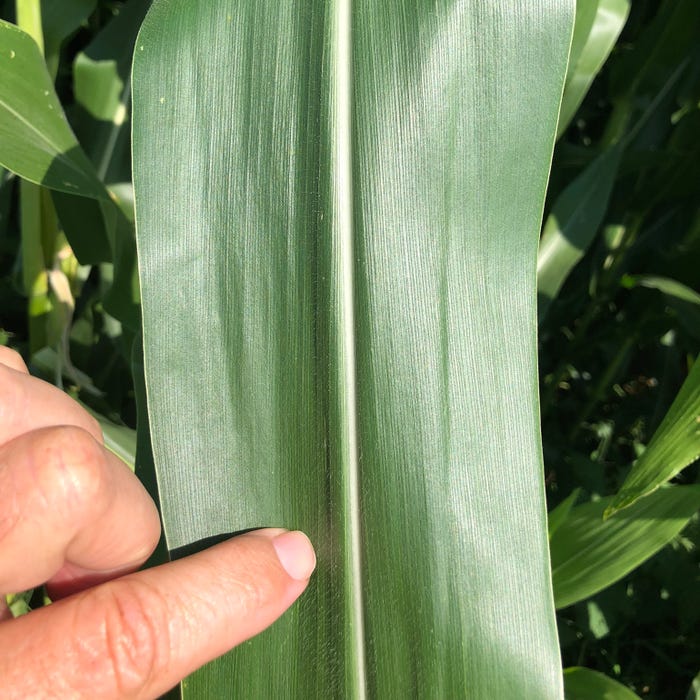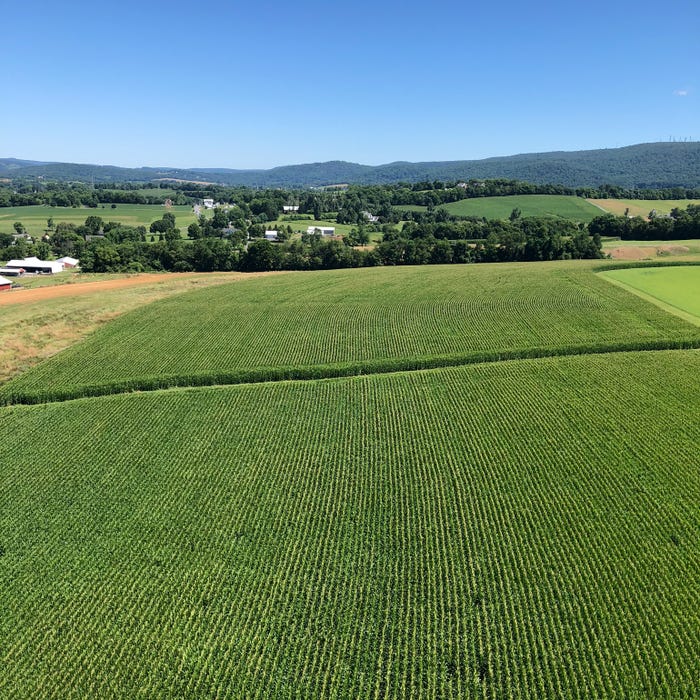
Drive through Frederick County, Md., and it’s easy to see farming being squeezed. Development is encroaching on many farms that have been producing for decades.
Drew Haines is dealing with this new reality by growing more corn and soybeans on his 600 acres of owned and rented land. But it’s not just about applying more fertilizer. Haines has adjusted his entire operation, from seed selection to multiple foliar applications, to achieve the highest yields possible.
"In farming today, there is no profit. The dairies are going out of business, the grain farmers are hardly making any money. To be profitable you have to make more grain on less acres," he says on a recent humid day on his farm just outside Middletown.
It was 2016 when Haines met up with Grant Troop, an agronomist working for AgXplore. Troop recalls good planting conditions, and Haines was able to get his seed in the ground early, but late April and early May turned out to be dry and cold.
"So, Drew had corn come up to the V3 stage and stopped growing," Troop says.
Haines asked what he had to get the crop going, so Troop suggested a 7-12-1 foliar fertilizer applied via helicopter.
Troop says the corn went to tassel early and yielded 40 bushels more than the untreated fields. It was applied to 25 acres in 2016.
"It was fascinating to see how the corn grew," he says.
In 2017, Haines continued tinkering with his program and increased his acreage in it. A foliar fertilizer was flown on between V3 and V5 corn, and later in the season. At tasseling, Haines, who works off the farm as a sales consultant for Eddie Mercer Agri-Services Inc., also put together his own concoction of "goodies" that he likes to call dillweed juice.
"I like to call it that because that’s the nickname my brother gave me as a kid," he says.
It doesn’t contain dillweed. Rather, it is a mix of macronutrients nitrogen, phosphorus and potassium (NPK); boron and zinc; humic and fulvic acids; and other things Haines likes to keep a secret. He applies 3 gallons to the acre.
"I started it with a backpack in my garden. Once I saw it was growing well there, I spread on the fields," he says.
The dillweed juice was again put on at brown silk.
 GOOD RESULTS: Haines looks over ears of corn on his farm. Early estimates have yields between 360 and 411 bushels.
GOOD RESULTS: Haines looks over ears of corn on his farm. Early estimates have yields between 360 and 411 bushels.

Haines says he saw his yields go up 50 bushels with the combination of foliar applications and dillweed juice.
For the 2018 crop, Haines worked with Troop on adding a pop-up fertilizer along with the foliar applications of fertilizer and dillweed juice. The results have been dramatic. Even with the heavy rains this summer, Troop says a check of the crop in mid-September showed yields ranging from 360 to 411 bushels an acre.
Impressive yields
The changes Haines implemented have him near the top nationally in corn yield on nonirrigated ground. In 2015 his corn plot for the National Corn Growers Association Corn Yield Contest was 303 bushels an acre. In 2016 his plot was 324 bushels an acre, first place in Maryland and second nationally in the nonirrigated category. He did even better in 2017 with 341 bushels an acre, again first in the state and second nationally.
All 250 acres of corn are on the fertilizer program.
He also has a high-yield program for his soybeans. Last year the crop averaged 86 bushels an acre.
Looking to the soil
But none of this would have been possible, Haines says, had he not started looking at his clay loam soils and decided that he needed to get more water in there.
 CROP PENETRATION: Haines likes aerial crop dusting by helicopter as it allows for more accurate application of fertilizer.
CROP PENETRATION: Haines likes aerial crop dusting by helicopter as it allows for more accurate application of fertilizer.

"It had been no-till for 18 to 19 years, but I decided to do tillage to break up the compaction," he says. "I think that helped to get water into the ground. We loosened up the soil a little bit."
He also did a soil test to find out what organic matter was in the ground and what needed to be fed.
Haines also increased his plant populations, going from 35,000 to 40,000 an acre.
Troop says it was key for Haines to start out with a good base of soil fertility and practices.
"You have to have that to drive high yields because at some point you will hit a limiting factor," he says. "The macro- and micronutrients matter."
Haines uses mostly DeKalb hybrids on the farm. He and his seedsman worked together to choose the hybrids that would give him the highest yield potential. This year, he used DeKalb 70-27 and 67-24 in his fields.
Haines says going with the high-yield program hasn’t been cheap, but it’s been worth the expense to his overall bottom line.
Troop says the lesson for other farmers is that it’s not just about applying more synthetic fertilizer at the right time.
"The thinking of straight chemical fertilizers giving you a huge advantage is generally not the case," Troop says.
 AN AERIAL VIEW: A view of Drew Haines’ farm in Middletown, Md., via Gene Kritter’s helicopter earlier this summer.
AN AERIAL VIEW: A view of Drew Haines’ farm in Middletown, Md., via Gene Kritter’s helicopter earlier this summer.

Many of the products Haines uses have soilborne humic compounds and plant extracts to stimulate plant growth.
According to Iowa State University Extension, humic and fulvic acids are the most characteristic compounds of soil humic substances. These substances are formed through the microbial degradation of plant material and are the primary constituents of soil organic matter. Humic substances can hold seven times their volume in water, a greater water holding capacity than clay soils, according to Iowa State, enabling plant roots to quickly access nutrients for growth.
A team effort
Haines also gives much of the credit to his crop dusting expert Gene Kritter of Culpeper, Va. Kritter says that crop dusting using a helicopter is more effective because you can get better penetration of chemicals on the plant. He can crop dust 100 acres an hour.
Mike Harrison, climate business manager for Climate Corp., worked with Haines on his hybrid seed selection. Although they didn’t chop for silage, one of the things he’s been impressed with is the good milk-per-ton readings — between 3,490 and 3,740 tons — on 10 stalks that were weighed and tested.
"I’ve learned a lot of stuff from him, mainly that ability to keep going after it. Don't give up on the crop even though you got a little bit of weather, it's tasseling, and you think it's done," Harrison says. "You feed that crop a little bit more and it will pay you back. You take that down to a per-bushel cost at the end of the year and they are way ahead of farmers who grow 150 bushels per acre.
"It’s just different farming than it was 10 years ago, and the guys that are like him are excelling."
About the Author(s)
You May Also Like






